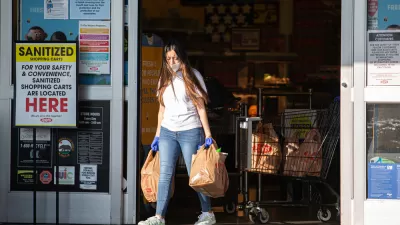Hasty reopenings by counties and bad behavior are blamed for soaring infection growth in California. Hospital and ICU beds in Los Angeles County, which has more coronavirus cases than any county in the U.S., could reach capacity by mid-July.

California's surging infections caught the attention of Anthony S. Fauci, the nation’s top infectious-diseases expert and director of the National Institute of Allergy and Infectious Diseases, who testified before the U.S. Senate Committee on Health, Education, Labor and Pensions (HELP) on Tuesday morning.
“I'm very concerned about what's going on right now, particularly in the four states that are accounting for about 50% of the new infections,” Fauci said in response to a question by Sen. Elizabeth Warren (D-Mass.). Those states are Florida, Texas, California, and Arizona which he had identified earlier in a response to a question by Sen. Patty Murray (D-Wash.), ranking member of the committee, on the pace of the reopenings of individual states. [See CNN video and text below "Fauci: The US is 'going in the wrong direction'".]
The Los Angeles Times reported Tuesday on the wrong direction, to quote Fauci, that California, and Los Angeles County in particular, has taken. "The county reported more than 3,000 new COVID-19 cases on Monday alone, also recording its largest single-day number of new infections, according to The Times’ coronavirus tracker." The county leads the nation with almost 101,000 confirmed COVID-19 cases, according to the Johns Hopkins Coronavirus Resource Center, followed by Cook County, Ill., with just over 90,000.
"California plummeted deeper into a new coronavirus crisis Monday as new cases spiked to record levels, some hospitals filled up, and officials expressed growing alarm and frustration with people refusing to follow safety rules despite the increasingly perilous conditions," report Colleen Shalby, Rong-gong Lin Il, Maura Dolan, and Jaclyn Cosgrove for the Los Angeles Times on June 30.
The state broke its record Monday for the greatest number of new coronavirus cases reported in a single day, tallying more than 8,000. That’s the third time in eight days the state has broken a record of new daily cases, according to the Los Angeles Times’ California coronavirus tracker.
[Correspondent's note: While the LA Times tracker indicates 8,244 cases recorded on June 29, the COVID-19 data dashboard operated by the California Department of Public Health that tracks positive cases, deaths, and testing results, indicates that 6,397 cases were recorded Monday, the second-highest after 7,149 were recorded on June 23. Total cases, almost 223,000 on June 30, have increased by over 45% from just two weeks ago.]
The increase in cases is attributed to the state's reopening, administered by the 58 individual counties though overseen by Gov. Newsom's administration, resulting in "people revert[ing] to old behaviors, returning to bars, barbecues and birthday parties," add Shalby, Lin, Dolan, and Cosgrove.
The new data show “alarming increases in cases, [test] positivity rates and hospitalization,” L.A. County Public Health Director Barbara Ferrer said.
Hospitalizations
California is among the 12 states showing an alarming increase in hospitalization rates noted by Dr. Robert Redfield, director of the US Centers for Disease Control and Prevention, who also addressed the HELP committee on Tuesday.
"L.A. County is now projecting the possibility of running out of hospital beds in two to three weeks," reported Lin on Monday. "Likewise, the number of intensive care unit beds could be exhausted sometime in July."
Test positivity and transmission
Ferrer, the county's public health office, "said the surge is proof — 'definitively' — that community transmission has increased, with the cumulative rate of those testing positive for infection increasing from 8% to 9%," add Shalby, Lin, Dolan, and Cosgrove.
Officials are now warning that 1 in 140 residents are probably unknowingly infected with the virus and contagious to others, a threefold increase over last week’s projection of 1 in 400.
The statewide coronavirus test positivity rate, the percentage of positive tests among total tests administered, is 5.6% or 5.9% when measured on a 14-day or 7-day rolling average, respectively, according to the Department of Public Health. The rate should not exceed 5%, according to Johns Hopkins. The U.S. 7-day rolling average on June 30 was 6.9%.
On June 30, California and seven other states with increasing infection states were added to the Tri-State Travel Advisory, meaning that they will need to self-quarantine for 14-days upon arrival in N.Y., N.J., or Conn. [See related post below.] By contrast, the Empire State's positive test rate was 1% on June 29.
Hat tip to Streetsblog California.
Related in Planetizen:
-
The New Tri-State Quarantine, June 25, 2020
-
The Rush to Open: California is No Exception, May 7, 2020
FULL STORY: California enters a perilous phase as coronavirus spread intensifies

Study: Maui’s Plan to Convert Vacation Rentals to Long-Term Housing Could Cause Nearly $1 Billion Economic Loss
The plan would reduce visitor accommodation by 25,% resulting in 1,900 jobs lost.

North Texas Transit Leaders Tout Benefits of TOD for Growing Region
At a summit focused on transit-oriented development, policymakers discussed how North Texas’ expanded light rail system can serve as a tool for economic growth.

Why Should We Subsidize Public Transportation?
Many public transit agencies face financial stress due to rising costs, declining fare revenue, and declining subsidies. Transit advocates must provide a strong business case for increasing public transit funding.

How to Make US Trains Faster
Changes to boarding platforms and a switch to electric trains could improve U.S. passenger rail service without the added cost of high-speed rail.

Columbia’s Revitalized ‘Loop’ Is a Hub for Local Entrepreneurs
A focus on small businesses is helping a commercial corridor in Columbia, Missouri thrive.

Invasive Insect Threatens Minnesota’s Ash Forests
The Emerald Ash Borer is a rapidly spreading invasive pest threatening Minnesota’s ash trees, and homeowners are encouraged to plant diverse replacement species, avoid moving ash firewood, and monitor for signs of infestation.
Urban Design for Planners 1: Software Tools
This six-course series explores essential urban design concepts using open source software and equips planners with the tools they need to participate fully in the urban design process.
Planning for Universal Design
Learn the tools for implementing Universal Design in planning regulations.
City of Santa Clarita
Ascent Environmental
Institute for Housing and Urban Development Studies (IHS)
City of Grandview
Harvard GSD Executive Education
Toledo-Lucas County Plan Commissions
Salt Lake City
NYU Wagner Graduate School of Public Service





























